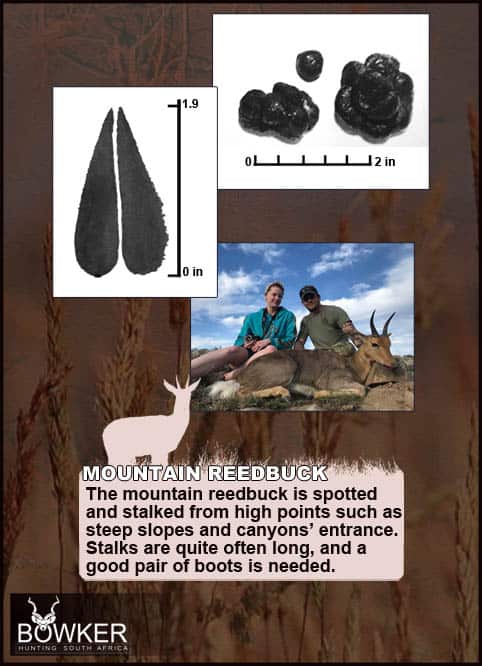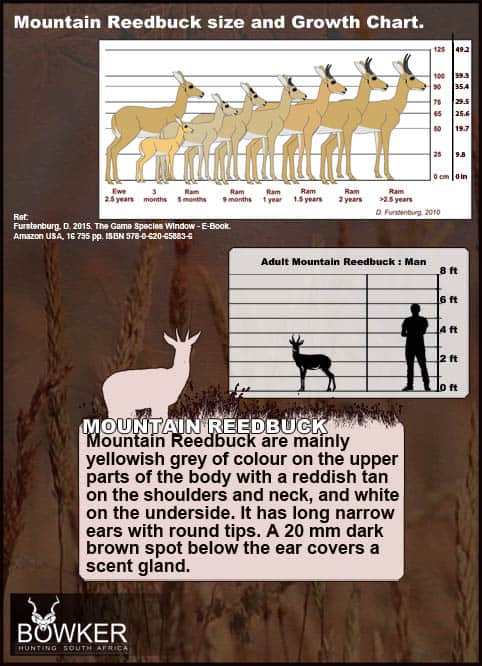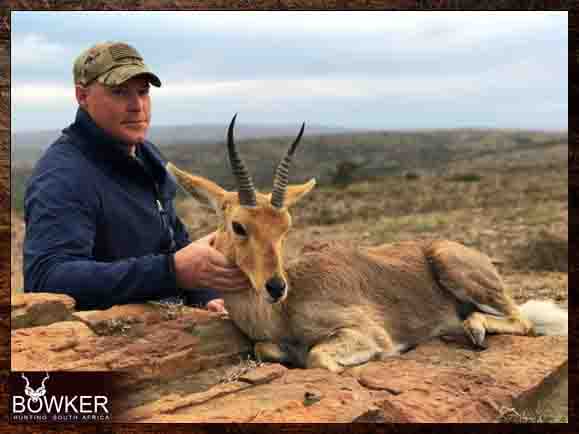
Summary
Mountain Reedbuck Trophy hunting is a more demanding game animal than the other reedbuck species in Africa.
The hunter will find these animals more challenging to hunt because they are much more wary antelope, inhabitants of more challenging terrain, and smaller body sizes make them a difficult target.
This species can only be hunted in South Africa.
There are no seasonal restrictions on hunting Mountain Reedbuck in designated conservancies in Eastern Cape, South Africa.
Nick Bowker Hunting offers Mountain Reedbuck safari hunting in South Africa year-round.
Safaris for this species are conducted from Hopewell Hunt Lodge. Bow hunting reedbuck in the mountainous terrain is challenging.
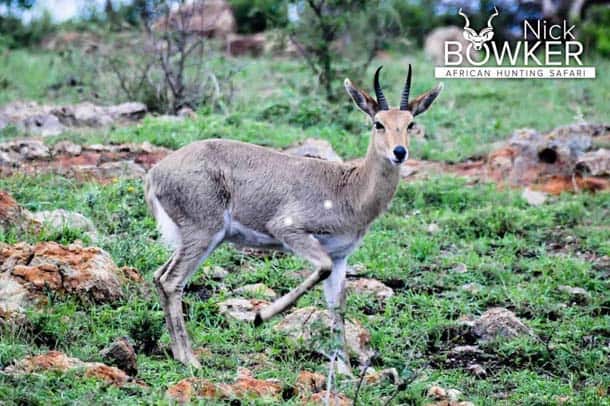
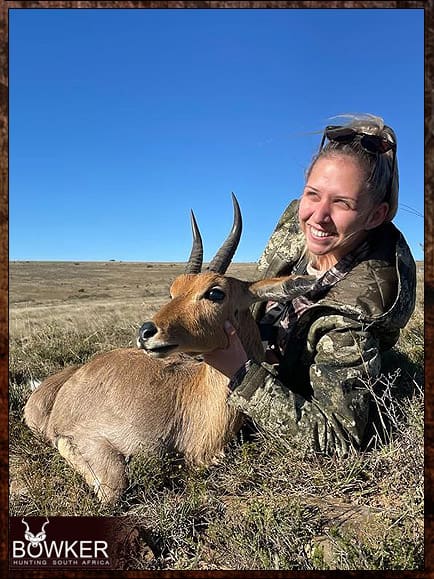
Table of Contents
Mountain Reedbuck Hunting Trophy Fees -2025
The average price for a Mountain Reedbuck is $350. A Plains game Africa hunts package can include hunting Mountain Reedbuck.
The Reedbuck Slam is also an excellent addition to any package and includes the common reedbuck, mountain reedbuck, and grey rhebok.
Our prices for 2025 are set out below.
- $350 Mountain Reedbuck Trophy Cost
- $1600 Common Reedbuck Trophy Cost
- $2500 Grey Rhebok Trophy Cost
All-Inclusive $5500 Starter Plains Game Package for seven trophies and eight days hunting.
- Kudu
- Impala
- BlackWildebeest
- Springbok
- Blesbok
- Warthog
- Mountain Reedbuck
Included in the Reedbuck trophy hunting package is a licensed hunting guide. As well as a hunting license and all permits.
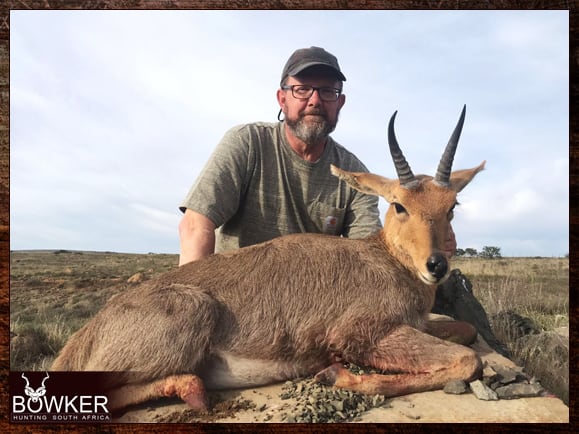
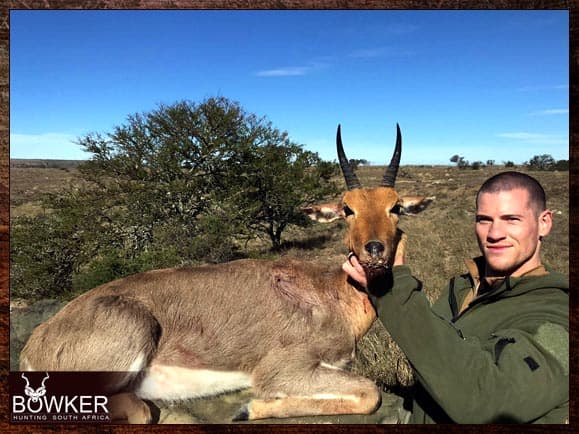
Hunting Mountain Reedbuck in South Africa
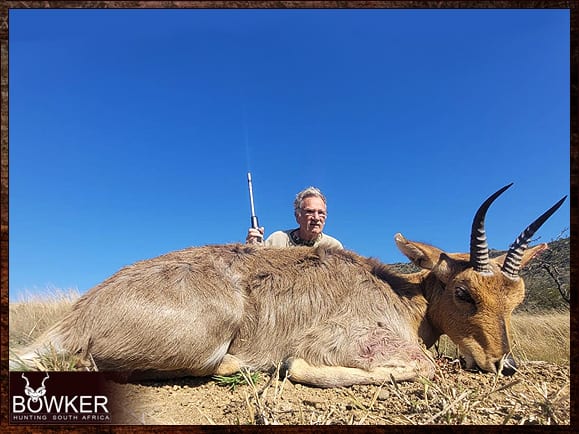
Your mountain reedbuck trophy should have an average shoulder height of around 29 inches, weigh about 65 pounds, and have a Horn Length of approximately 5 inches.
The minimum Safari Club International score for a mountain reedbuck is 11. Add the length of each horn and the bases’ circumference to get your SCI score.
Trophy Reedbuck hunting can be a more complex animal to hunt than the other Reedbuck species in South Africa. However, the Bedford area’s population density is unusual and makes life much more accessible than in other parts of the country.
As a result, the hunter will find these animals much warier and live on more challenging terrain. Also, its smaller body size makes it a difficult target.

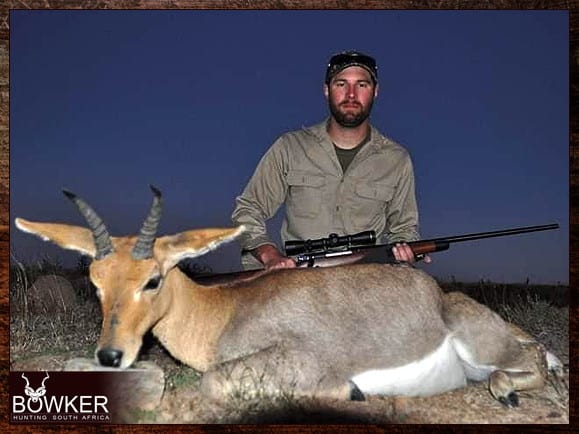
Hunting Mountain Reedbucks are spotted and stalked from high points such as steep slopes and canyon entrances.
Stalks are often long, and a good pair of boots is needed.
Hunters often find the female lying in the grass or under a tree. The male will most likely be lying a little away from the female.
The trick is to avoid being spotted by his harem. The best scenario is to find a bachelor ram on his own.
Warthog is often a hindrance when hunting mountain reedbuck as they share the same areas.
The focus is on the mountain reedbuck; a sleeping warthog under a bush will not be spotted and give the game away and blow your planned stalk.
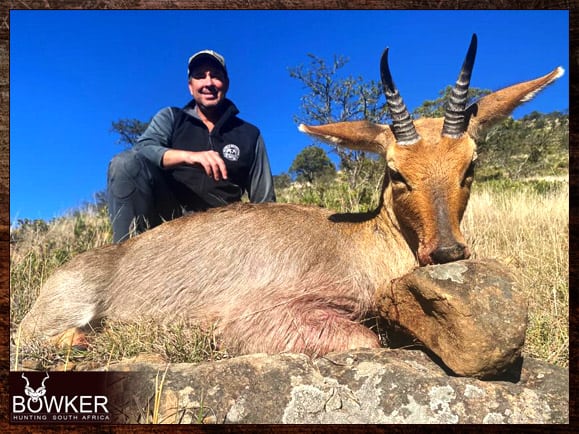
Trophy Judgement and Rifle Caliber for Hunts
Trophy Judgement
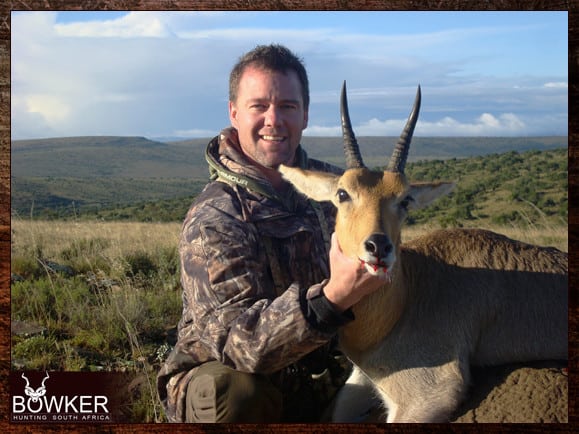
The Mountain Reedbuck’s horns tend to be shorter than the common reedbuck but still have the characteristic curve forward at the horns’ tips.
Any set that goes past the ear lengths will be a good trophy.
They are wary but often inquisitive – a trait the hunter can use to his advantage.
They graze and drink early in the morning, late afternoon, or even at night, usually resting in the shady spaces of their habitat during midday.
Mountain Reedbuck hunters can expect shots to be longer.
To judge the Mountain Reedbuck trophy quality, one must always look at the neck’s size: a thick, darkened, well-set neck is the first sign of a mature animal.
The horns are shaped like hooks, hooking forward with a good base. Therefore, always look to harvest a male with horns in line with the ears’ tips or greater.
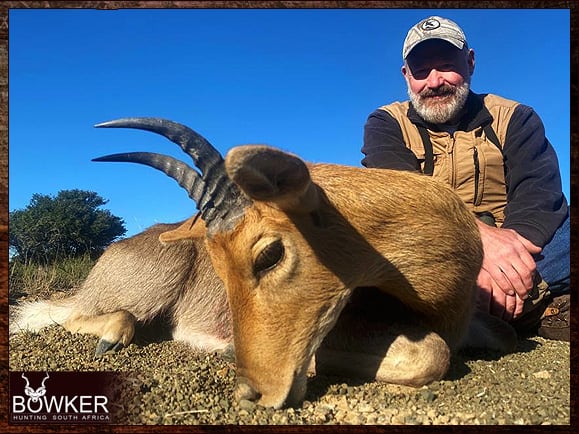
Rifle caliber
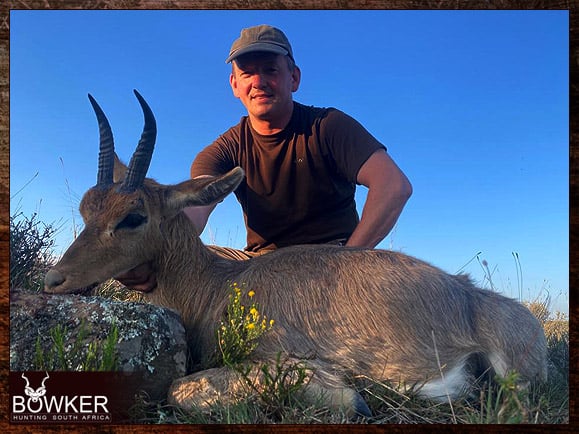
The Eastern Cape region of South Africa is probably the best area to hunt these mountain dwellers, where hunters will enjoy great numbers and exciting hunting.
Often spotted on the slopes of valleys and draws while glassing for kudu or eland.
For those hunters who wish to avoid going through the red tape of bringing a rifle into South Africa, Nick Bowker has 300 Magnums fitted with suppressors.
Mounted on the guns are Swarovski Z8 tactical scopes. Guides operate the distance adjustments for you.
We have hand-loaded Hornady ELD-X ammunition for your safari in Africa.
The rifle, including ammunition, is available as part of all hunting packages free of charge.
Include Mountain Reedbuck Trophy hunting in your African hunting safari; you won’t regret the decision.
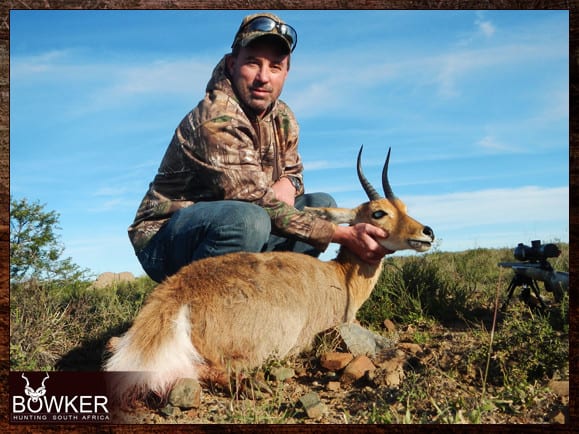
Difference Between a Male and Female game
Mountain Reedbuck males have horns, while females do not. In this case, two females are pictured below with a young male.


Interesting Facts for hunters
- Mountain reedbuck are active throughout the day and night, showing the most activity around dawn and dusk, and frequently rest when temperatures are high.
- Although the species is social (usually females are found in small herds), groups are unstable: individuals may switch groups regularly. Females occupy home ranges of around half a mile, which overlap several smaller male territories.
- The male use of body posturing and vocalizations is to maintain boundaries between neighboring males.
- Females prefer territories with steep slopes to escape predators, irrespective of the presence of food or water. As a rule, population densities are 5-9 animals per half a mile in South Africa.
- Males are solitary and territorial but associate with females as they pass through their territory. Immature males live in small bachelor groups.

- Where conditions are favorable, breeding occurs year-round. Whereas in South African regions with harsh winters, most births happen in the austral summer (mostly November and December).
- Lambs are tucked away in dense vegetation by their mothers for at least one month when they will visit to nurse them.
- One lamb is born after a gestation period of approximately eight months. Weaning occurs after about a year.
- Females reach sexual maturity as early as 9-12 months, though they are not fully mature until 18-24 months.
- In the East Cape South Africa, males will reach full maturity at around twenty-seven months of age.
- Mountain Reedbuck hunts differ significantly from the common Reedbuck due to the habitat difference.

About the Reedbuck for Hunting

The mountain reedbuck averages 30 inches at the shoulder and weighs around 65 pounds.
It has a gray coat, white underbelly, reddish-brown head, and shoulders.
The male has ridged horns of about 6 inches, which curve forward. The male and the female have a dark scent patch beneath the ears.
This medium-sized antelope is found in the Cape province of South Africa and on the Free State on rocky slopes.

The ears’ points are rounded, and the most noticeable feature is their big, white, bushy tails.
A typical group is several adult females and juveniles and one nomad male. Adolescent males are forced out of their herds and form small bachelor herds.
Mountain Reedbuck is a hugely underrated hunt experience in Africa.
The Mountain Reedbuck is different from the Common and Bohor Reedbuck.
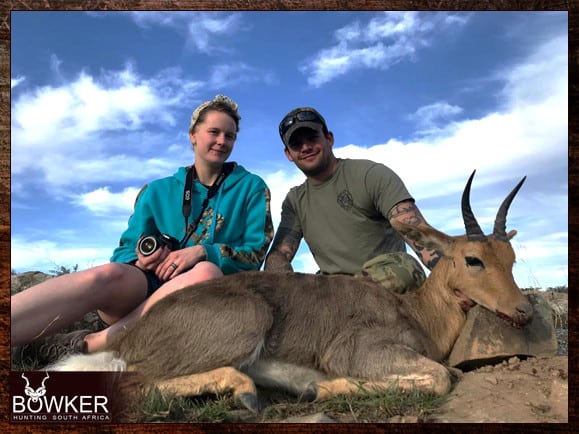
Frequently Asked Questions
How much does it cost to hunt a Mountain Reedbuck?
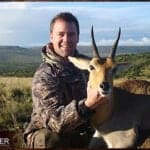
Trophy fees as a standalone Mountain Reedbuck hunt are between $300 to $500. Daily rates vary between $250 to $500 a day.
Included in the Mountain Reedbuck trophy fee is a licensed guide. As well as a hunting license and all permits.
A Mountain Reedbuck trophy is often included in a Plains game package. Package prices vary from $3,000 – $10,000, depending on location and size. Packages include 5 – 7 trophy animals, accommodation, meals, and daily rates.
How to hunt a Mountain Reedbuck?
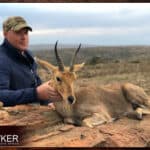
Mountain reebuck hunting is in the early mornings and late evenings, and the reebuck is spotted from an elevated vantage point in the thick brush and then stalked.
Where do you shoot a Mountain Reedbuck?
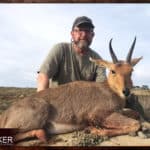
Shot placement must be in the bottom third of the animal directly above the front shoulder. This will ensure a heart or lung shot. Avoid head and neck shots, which are high-risk.
How do you judge a Mountain Reedbuck trophy?
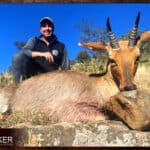
As with all African animals, a thick, heavy, darkened neck is the first sign of maturity and often the most visible maturity characteristic when observing at a distance.
The horns are shaped like hooks, hooking forward with a good base. Therefore, always look to harvest a male with horns in line with the ears’ tips or greater.
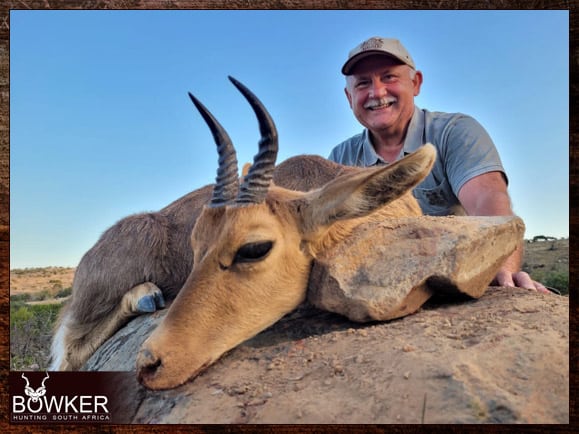
Seasonal Restrictions
When can you hunt Mountain Reedbuck in South Africa?
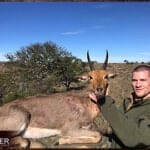
No seasonal restrictions on mountain reedbuck hunting are in designated conservancies in the Eastern Cape of South Africa.
Difference between the Common and Mountain Reedbuck
What is the difference between a Mountain Reedbuck and a Common Reedbuck?

The mountain reedbuck is smaller than the common or southern reedbuck and has smaller horns. The horns of the common reedbuck also angle outwards.
The common reedbuck has a lighter shade of color. As the name suggests, mountain reedbuck is found in mountainous rocky areas, while the common reedbuck is found more in woodlands and savanna.


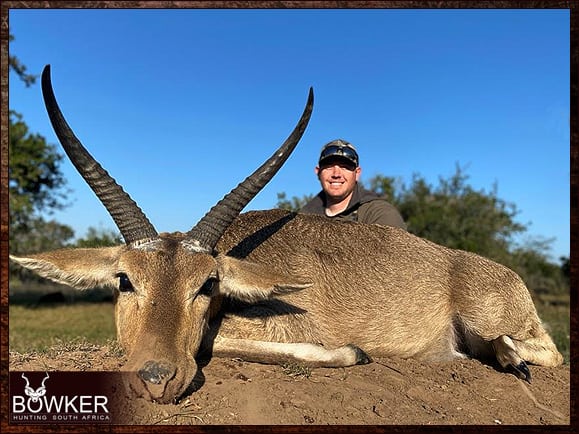
The Difference between a Mountain Reedbuck and a Grey Rhebok
What is the difference between a Mountain Reedbuck and a Grey Rhebok?

Mountain Reedbuck has curved horns, while the grey rhebok has straight horns, which are longer but with smaller bases.
The coloration is very similar, and they are often confused as the mountain reedbuck and grey rhebok females do not have horns. The grey Rhebok tends to live at greater altitudes than the mountain reedbuck.

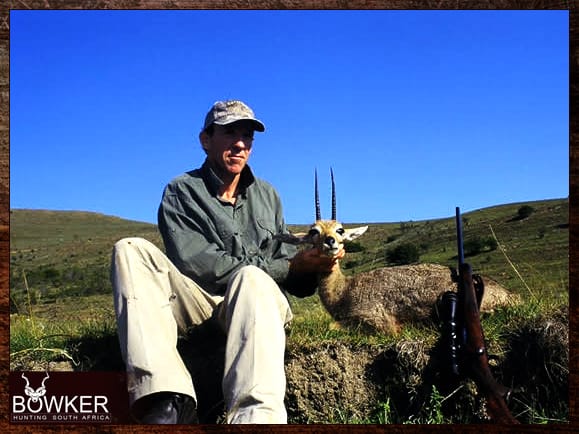
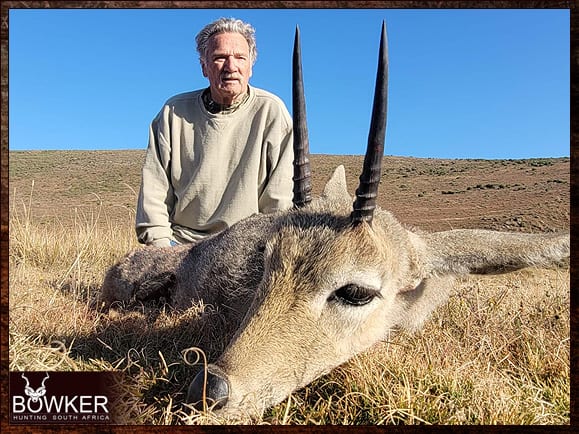
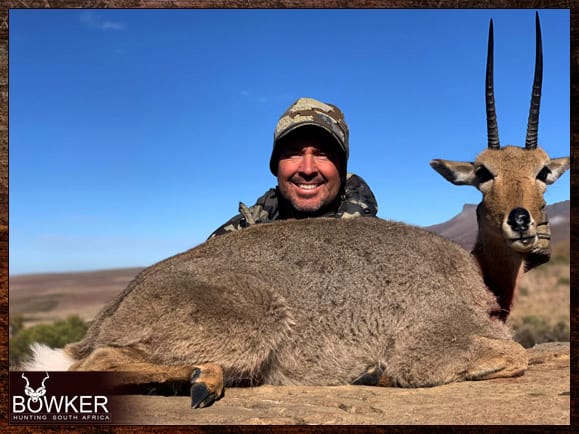
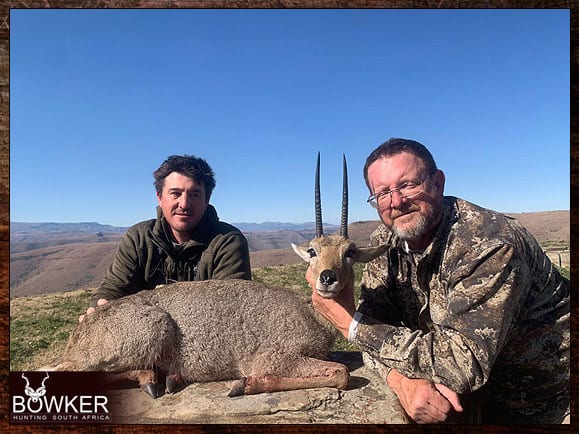
In Pictures








